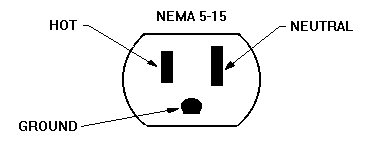[ The PC Guide | Systems and Components Reference Guide | Power | External Power | Uninterruptible Power Supplies | Parts of the Uninterruptible Power Supply ]
Power Cord
Huh? I want to talk about the power cord? What's there to talk about? Well, in the case of smaller UPSes, not much, just as you would suspect. However, with larger UPSes the power cord is something you need to pay attention to. (Sorry, but this discussion will be somewhat North-America-centric; that's what I am familiar with. I am sure that my international friends can generalize the concepts to their models and standards bureaus.)
Standard household outlets in North America are given the designation NEMA 5-15 ("NEMA" is the National Electrical Manufacturers Association.) They are rated to a maximum of 125V and 15A of current. Multiplying these numbers gives us about 1875 VA, which is the theoretical maximum UPS size that a standard outlet can handle. In practice, because nobody wants to "cut it close", and because the voltage is usually below 125V, the limit of a standard socket is 1440 VA. Most smaller UPSes use the standard plug.
|
Illustration of a standard North American household electrical plug.. |
Original image � American Power Conversion Corp. |
In order to go to a larger unit (to provide increased run time or to handle more equipment) you need to have an electrician provide a special, higher-capacity circuit for the UPS. These high-amperage circuits use thicker wire (which has less resistance) to safely allow more current to pass. To distinguish such a high-capacity circuit from a regular one, different plug shapes are normally used. There are in fact dozens of differently-shaped plug/receptacle standards, to handle the various combinations of voltage and current. It is also common to see these higher-capacity outlets installed as twist-lock sockets, taking twist-lock plugs instead of the standard straight blades we are used to; The twist-lock receptacle and plug prevent the power cord from being accidentally pulled from the wall.
|
NEMA 5-30 plugs, straight blade and twist-lock. These
plugs are |
Original images � American Power Conversion Corp. |
The moral of the story is pretty simple here: make sure you check the plug specification of the UPS, especially on larger models, to avoid nasty surprises when you try to plug in the UPS!
![]() Next: Main Power Switch
Next: Main Power Switch
| The PC Guide
(http://www.PCGuide.com) Site Version: 2.2.0 - Version Date: April 17, 2001 © Copyright 1997-2004 Charles M. Kozierok. All Rights Reserved. |
Not responsible for any loss resulting from the use of this site. Please read the Site Guide before using this material. |


